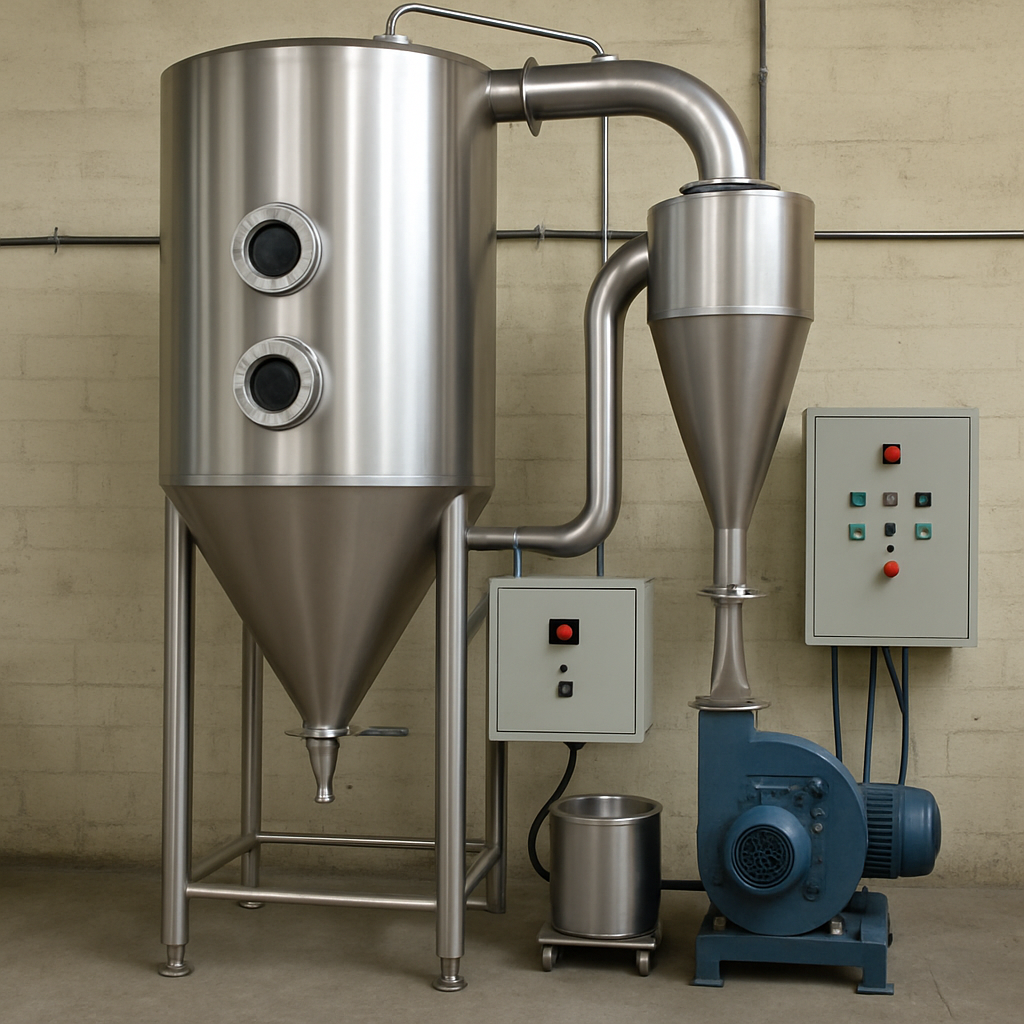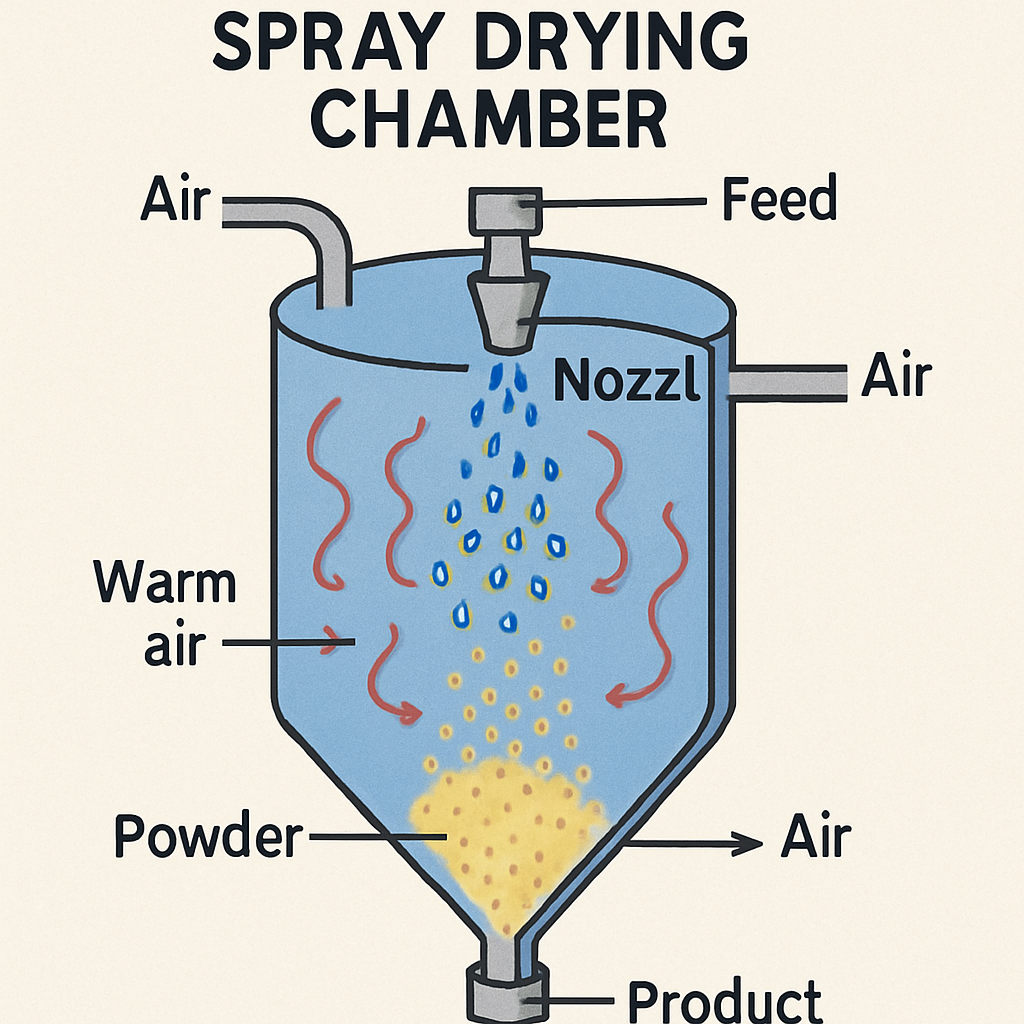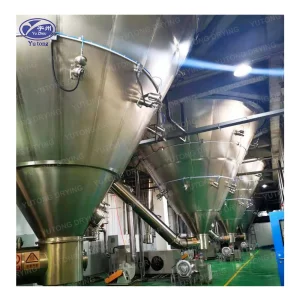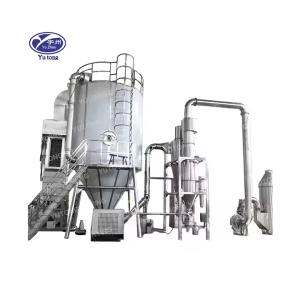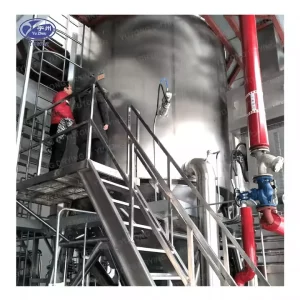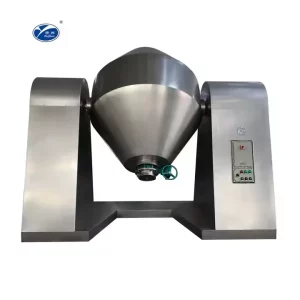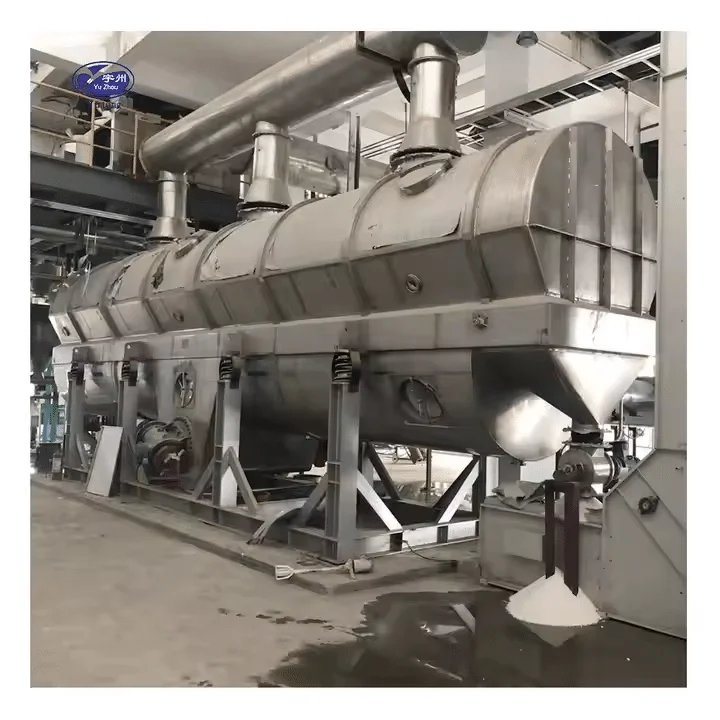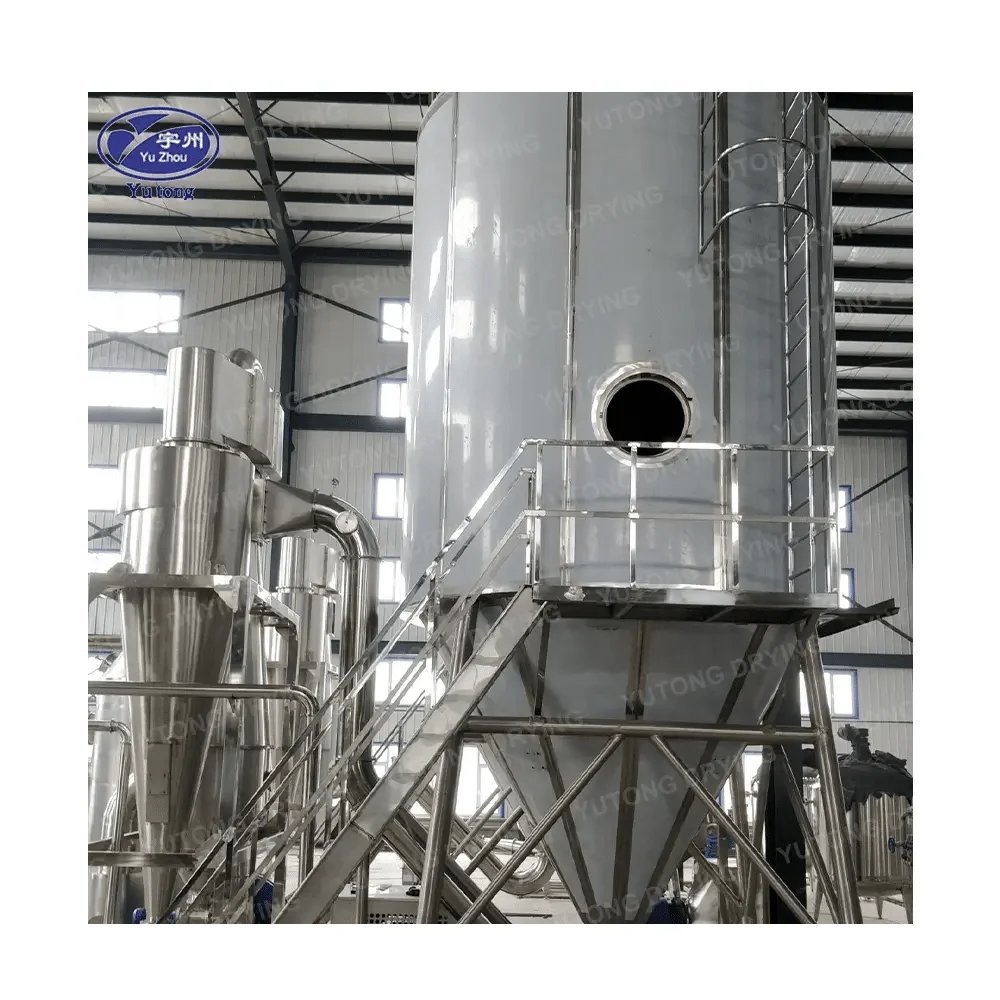Spray drying is a fascinating and highly efficient method used to produce dry powders from a liquid or slurry. This process is widely used in various industries, including food, pharmaceuticals, and chemicals, to transform liquid mixtures into powder form. But how exactly does spray drying work? In this article, we’ll break down the spray drying process, explore its components, and understand why it’s such a valuable technology across different fields.
Spray drying is a method of producing a dry powder from a liquid by rapidly drying it with a hot gas. This technique involves several carefully coordinated processes to ensure the efficient conversion of liquid into a fine, dry powder.
The Basics of Spray Drying
At its core, spray drying involves the transformation of liquid droplets into dry particles through evaporation. This is achieved by spraying the liquid into a heated chamber, where the liquid droplets meet hot air, causing rapid evaporation. The result is a fine, dry powder that can be easily collected and packaged. This method is particularly beneficial when dealing with heat-sensitive materials, as the rapid drying process minimizes thermal degradation.
Historical Background
The concept of spray drying dates back to the late 19th century, with significant advancements occurring during the 20th century. It was initially developed to preserve food products, but its applications have since expanded into various industries. Understanding the historical context of spray drying provides insight into its evolution and the technological advancements that have made it a staple in modern manufacturing processes.
Key Characteristics
Spray drying is characterized by its ability to produce uniform particle sizes, its adaptability to different liquid inputs, and its efficiency in terms of energy use. The process is versatile, allowing for the handling of a wide range of liquid viscosities and compositions. This adaptability makes it suitable for diverse applications, from food production to pharmaceuticals and beyond.
The Spray Drying Process
To understand how spray drying works, let’s dive into its core stages:
Stage 1: Atomization
Atomization is the first step in the spray drying process, where the liquid feed is transformed into small droplets. This is usually done using an atomizer or spray nozzle. The atomizer breaks the liquid into tiny droplets, increasing the surface area and allowing for faster evaporation.
Importance of Atomization
The efficiency of the atomization process directly affects the quality of the final powder product. The size and uniformity of the droplets are crucial in determining the drying rate and the characteristics of the final powder. A well-executed atomization step ensures that the droplets are uniformly distributed within the drying chamber, promoting consistent drying.
Types of Atomizers
There are various types of atomizers, each suited to different applications. Rotary atomizers, nozzle atomizers, and ultrasonic atomizers are common types, each offering distinct advantages. Rotary atomizers, for example, are known for producing fine droplets, while ultrasonic atomizers are ideal for handling delicate or heat-sensitive materials.
Factors Affecting Atomization
Several factors influence atomization, including liquid viscosity, feed rate, and atomizer design. These factors must be carefully controlled to achieve optimal droplet formation. Adjustments to the atomization process can significantly impact the efficiency and effectiveness of the spray drying operation.
Stage 2: Drying Chamber
Once the liquid is atomized, the droplets are introduced into a drying chamber. In this chamber, hot air is blown in, usually at temperatures ranging from 150°C to 300°C, depending on the material being dried.
Role of the Drying Chamber
The drying chamber is where the transformation from liquid to powder occurs. The hot air causes the moisture in the droplets to evaporate quickly, leaving behind solid particles. The design of the drying chamber ensures that the droplets have enough time to dry completely before reaching the walls or bottom, preventing agglomeration or sticking.
Temperature Control
Temperature control is vital in the drying chamber to ensure product quality and process efficiency. The temperature must be high enough to facilitate rapid evaporation but not so high as to degrade the material being dried. Precise temperature management is essential, especially when dealing with temperature-sensitive substances.
Chamber Design Considerations
The size and shape of the drying chamber can vary significantly, depending on the desired output and the properties of the material being dried. Factors such as airflow patterns, residence time, and chamber dimensions are carefully considered during the design phase to optimize drying efficiency and product quality.
Stage 3: Separation
After the droplets are dried, the resulting powder needs to be separated from the air. This is typically done using cyclones or bag filters.
Separation Techniques
Cyclones use centrifugal force to separate the heavier particles from the air stream. This method is efficient for larger particles. Bag filters, on the other hand, trap the powder in a filter medium, which is ideal for finer powders. The choice between cyclones and bag filters depends on the specific requirements of the product and the desired powder characteristics.
Efficiency of Separation
Effective separation is crucial to ensure that the maximum amount of powder is collected, minimizing waste and maximizing yield. Proper separation techniques also prevent contamination and ensure that the powder meets the required purity and quality standards.
Post-Separation Processing
Once collected, the powder may undergo additional processing, such as sieving or milling, to achieve the desired particle size distribution. This step ensures that the final product meets the specific requirements for its intended application.
Spray Drying Technology Components
Spray drying involves several key components that work together to ensure efficient drying. Let’s take a closer look at these components:
Atomizers
Atomizers are crucial for creating the fine droplets necessary for effective spray drying.
Rotary Atomizers
Rotary atomizers use a high-speed rotating disk to disperse the liquid into droplets. This type of atomizer is well-suited for handling large volumes of liquid and producing uniform droplets, making it ideal for industrial-scale applications.
Nozzle Atomizers
Nozzle atomizers force the liquid through a small orifice to create a spray. They are versatile and can be adjusted to produce a range of droplet sizes, making them suitable for various applications, including those requiring precise control over particle size.
Ultrasonic Atomizers
Ultrasonic atomizers use ultrasonic waves to break the liquid into droplets. This method is particularly effective for delicate or heat-sensitive materials, as it generates minimal heat during the atomization process, preserving the material’s integrity.
Drying Chamber
The drying chamber is where the actual drying takes place.
Chamber Design Variability
The design of the drying chamber can vary widely, depending on the intended application and the properties of the material being dried. Factors such as chamber height, diameter, and airflow patterns are carefully optimized to ensure efficient drying.
Material Considerations
The materials used in the construction of the drying chamber must withstand high temperatures and resist corrosion. Stainless steel is a common choice due to its durability and resistance to chemical reactions, ensuring the longevity and reliability of the drying system.
Airflow Management
Effective airflow management is critical to ensure that the droplets are uniformly distributed within the chamber. Proper airflow patterns prevent the droplets from sticking to the chamber walls and facilitate consistent drying across the entire batch.
Heat Source
A reliable heat source is essential for the spray drying process.
Types of Heat Sources
Gas and electric heaters are commonly used to generate the hot air required for drying. Gas heaters are often preferred for their efficiency and cost-effectiveness, while electric heaters offer precise temperature control, which can be crucial for sensitive materials.
Temperature Regulation
Temperature regulation is crucial to prevent overheating and degradation of the material being dried. Advanced control systems are used to maintain consistent temperatures, ensuring optimal drying conditions and preserving the quality of the final product.
Energy Efficiency
Energy efficiency is a key consideration in the design of the heat source. Innovations in heat recovery and insulation have significantly improved the energy efficiency of modern spray drying systems, reducing operational costs and environmental impact.
Powder Collection System
Once the powder is dried, it needs to be collected efficiently.
Cyclones and Bag Filters
Cyclones and bag filters are the primary methods for powder collection. Cyclones are effective for larger particles, while bag filters are ideal for finer powders. The choice of collection system depends on factors such as the size of the powder particles and the specific application.
Ensuring Product Purity
The collection system plays a crucial role in ensuring product purity. Properly designed systems minimize the risk of contamination and ensure that the collected powder meets stringent quality standards.
Post-Collection Handling
After collection, the powder may require further processing, such as blending or packaging. Proper handling and storage are essential to maintain the powder’s quality and stability until it reaches its final destination.
Benefits of Spray Drying
Spray drying offers several advantages that make it a preferred choice for producing powdered products:
Rapid Drying
Spray drying is a fast process that can handle large volumes of liquid, making it suitable for industrial-scale production.
High Throughput
The high throughput capabilities of spray drying enable manufacturers to produce large quantities of powdered products efficiently. This is particularly beneficial in industries where demand is high, such as food and pharmaceuticals.
Reduced Processing Time
The rapid drying process significantly reduces processing time compared to other drying methods. This efficiency allows for quicker turnaround times and increased production capacity.
Energy Conservation
Spray drying’s rapid drying capabilities often result in lower energy consumption per unit of product, contributing to cost savings and a reduced environmental footprint.
Controlled Particle Size
The atomization process allows for precise control over the size and uniformity of the powder particles.
Consistency in Product Quality
Consistent particle size is crucial for ensuring uniformity in product quality. This consistency is particularly important in applications where precise dosing and delivery are required, such as pharmaceuticals.
Customization for Specific Applications
The ability to control particle size allows manufacturers to tailor the powder’s properties to meet specific application requirements. This customization enhances the versatility and applicability of spray-dried products across various industries.
Improved Solubility and Flowability
Controlled particle size can enhance the solubility and flowability of the final product, improving its performance in subsequent processing or consumer use.
Preservation of Quality
The rapid drying process helps preserve the quality and nutritional content of sensitive materials, such as food and pharmaceuticals.
Nutrient Retention
The gentle drying conditions of spray drying help retain the nutritional content of food products, preserving vitamins and other essential nutrients. This retention is vital for maintaining the health benefits of processed foods.
Preservation of Active Ingredients
In pharmaceuticals, spray drying preserves the integrity of active ingredients, ensuring their efficacy in the final product. This preservation is crucial for maintaining the therapeutic value of medications.
Minimization of Thermal Degradation
The rapid evaporation process minimizes exposure to high temperatures, reducing the risk of thermal degradation and preserving the material’s structural and chemical properties.
Versatility
Spray drying can be used with a wide range of materials, including heat-sensitive substances that may degrade with other drying methods.
Adaptability to Different Inputs
Spray drying is adaptable to various input materials, from aqueous solutions to organic solvents. This adaptability makes it suitable for diverse applications across different industries.
Compatibility with Complex Formulations
Spray drying can handle complex formulations, including those containing multiple components or additives. This compatibility allows for the production of multifunctional powders with tailored properties.
Expansion into Emerging Applications
The versatility of spray drying enables its application in emerging fields, such as biotechnology and nanotechnology, where precise control over particle size and composition is essential.
Applications of Spray Drying
Spray drying is employed in various industries due to its versatility and efficiency. Some common applications include:
Food Industry
by Benjamin DeYoung (https://unsplash.com/@benjamin_deyoung)
In the food industry, spray drying is used to produce milk powder, coffee, tea, egg powder, and flavorings.
Nutritional Benefits
The process helps retain the nutritional value and flavor of the products while providing a convenient and stable powder form. This is particularly important in products like milk powder, where nutrient retention is critical for health benefits.
Shelf Life Extension
Spray drying extends the shelf life of food products by reducing moisture content, which inhibits microbial growth. This extension is crucial for products like coffee and tea, where freshness and flavor retention are paramount.
Convenience and Portability
Spray-dried food products offer convenience and portability, making them ideal for consumer use. The stable powder form allows for easy packaging, storage, and transportation, enhancing product accessibility and convenience.
Pharmaceutical Industry
In pharmaceuticals, spray drying is used to create powders for inhalers, antibiotics, and other medications.
Precise Dosage Control
The process allows for precise control over particle size, ensuring consistent dosing and delivery. This precision is essential for maintaining the efficacy and safety of pharmaceutical products.
Enhancement of Bioavailability
Spray drying can improve the bioavailability of active ingredients by enhancing their solubility and dispersibility. This enhancement is crucial for optimizing the therapeutic effects of medications.
Formulation Flexibility
The flexibility of spray drying allows for the development of innovative drug formulations, including sustained-release and targeted delivery systems. This flexibility enables the creation of advanced pharmaceutical products with enhanced performance.
Chemical Industry
In the chemical industry, spray drying is used to produce a wide range of chemicals, including catalysts, detergents, and pigments.
Uniform Particle Production
The ability to produce uniform particles makes spray drying an ideal choice for these applications. Uniformity is essential for ensuring the consistency and performance of chemical products.
Process Efficiency
Spray drying offers a highly efficient method for producing chemical powders, reducing production time and costs. This efficiency is beneficial for large-scale manufacturing operations.
Tailored Product Properties
Spray drying allows for the customization of product properties, such as particle size and shape, to meet specific application requirements. This customization enhances the functionality and effectiveness of chemical products.
Conclusion
Spray drying is a powerful technique that transforms liquid solutions into dry powders efficiently and effectively. By understanding the spray drying process and the technology involved, industries can leverage this method to produce high-quality powdered products that meet their specific needs. Whether it’s in the food, pharmaceutical, or chemical industry, spray drying continues to play a crucial role in transforming raw materials into valuable, easy-to-use products.
Through innovations and advancements in technology, spray drying remains a vital process, contributing to the development of new products and the improvement of existing ones. Its versatility, efficiency, and ability to preserve the integrity of sensitive materials make it an indispensable tool across various sectors, driving progress and innovation in the manufacturing world.

